Corned beef brisket is a type of meat that has been a staple in many households for generations. It is essential in traditional dishes such as corned beef hash, sandwiches, and stews. However, despite its popularity, not everyone is familiar with what corned beef brisket is.
In this article, we’ll explore what is corned beef brisket and its origins, preparation, and common uses of this flavorful meat. Whether you’re a beef aficionado or just curious about trying new foods, keep reading to discover what makes corned beef brisket so special.
What Is Corned Beef Brisket?
Corned beef brisket is a delicious and flavorful meat perfect for many dishes. It is made by curing a cut of beef brisket in a seasoned brine, which gives it its distinctive tangy and salty taste. It can be boiled, slow-cooked, or even pressure-cooked to create a tender and juicy meat perfect for sandwiches and stews. While it may be sold as an uncooked cut of beef, corned beef brisket has already undergone a process of curing and seasoning that makes it unique. Whether enjoyed on St. Patrick’s Day or any time of the year, corned beef brisket is a tasty and versatile meat that will surely be a hit with anyone who loves beef.
The History of Corned Beef on St. Patrick’s Day
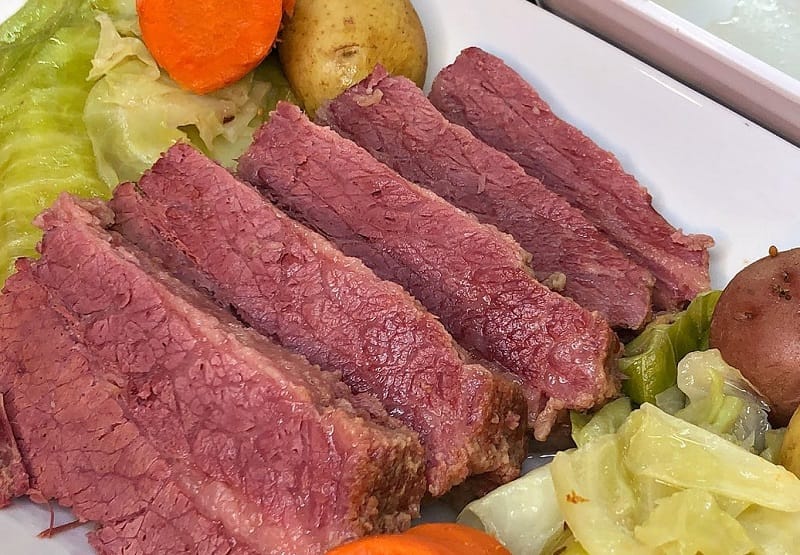
St. Patrick’s Day is celebrated around the world on March 17th each year. It is a day to celebrate Irish culture, heritage, and traditions. One of the most popular dishes on St. Patrick’s Day is corned beef, a dish that has been around since the 17th century.
The origin of corned beef is thought to have come from the English and Irish, who started preserving beef by curing it in brine. This curing process helps to preserve the beef, and it was commonly used during long voyages.
The term “corned” comes from the salt grains used to cure the beef were about the size of corn kernels. The Irish immigrants who came to America in the 19th century adopted this process of curing beef.
Corned beef became a popular dish in the United States in the late 19th century. One of the first references to corned beef on St. Patrick’s Day is from an 1871 New York Times article. The article noted that corned beef was served at a St. Patrick’s Day dinner.
In the early 20th century, corned beef became popular in Irish-American communities. In many Irish-American households, serving corned beef on St. Patrick’s Day became a tradition.
Today, corned beef is still a popular dish on St. Patrick’s Day. It is served in many restaurants, pubs, and homes throughout the United States and across the world. Its popularity is a testament to its long history and association with Irish-American culture.
How Does Corned Beef Brisket Compare To Other Types Of Meat In Terms Of Taste And Texture?
When it comes to taste, corned beef brisket has a distinct flavor. It is slightly sweet and salty, with a hint of smokey flavor. It is usually served with potatoes, cabbage, and other vegetables.
In terms of texture, corned beef brisket is known for its tenderness. The meat is usually cooked for several hours over low heat, resulting in a juicy, fork-tender texture.
Compared to other types of meat, corned beef brisket is an excellent choice for its flavor and texture. It is perfect for the corned beef hash, Reuben sandwiches, or classic corned beef and cabbage.
When it comes to taste, corned beef brisket stands out among other types of meat. Its unique flavor perfectly complements potatoes, cabbage, and other vegetables. It is also a great option if you’re looking for a juicy, fork-tender texture.
Health Benefits Associated With Eating Corned Beef Brisket
Corned beef brisket is rich in protein, essential for a healthy diet. It is also a great source of iron, zinc, and selenium, all necessary for proper immune system functioning. Additionally, corned beef brisket contains various B vitamins, which can help boost energy levels and improve overall health.
While corned beef brisket is a great source of nutrition, it also provides a number of other health benefits. This type of meat is low in fat and calories, making it a great choice for anyone looking to stay healthy and maintain a healthy weight. Additionally, corned beef brisket is high in niacin and phosphorus, which are linked to improved cardiovascular health.
When cooked properly, corned beef brisket is also a great source of dietary fiber. This type of fiber helps to reduce cholesterol levels, as well as improve digestion. Fiber can also help to keep you feeling full for longer, which can help to reduce your overall calorie intake.
Overall, corned beef brisket is a tasty and nutritious dish that can provide you with various health benefits. From providing you with essential vitamins and minerals to helping reduce cholesterol and improve digestion, this meat is an excellent addition to any meal.
Tips For Selecting High-Quality Corned Beef Brisket
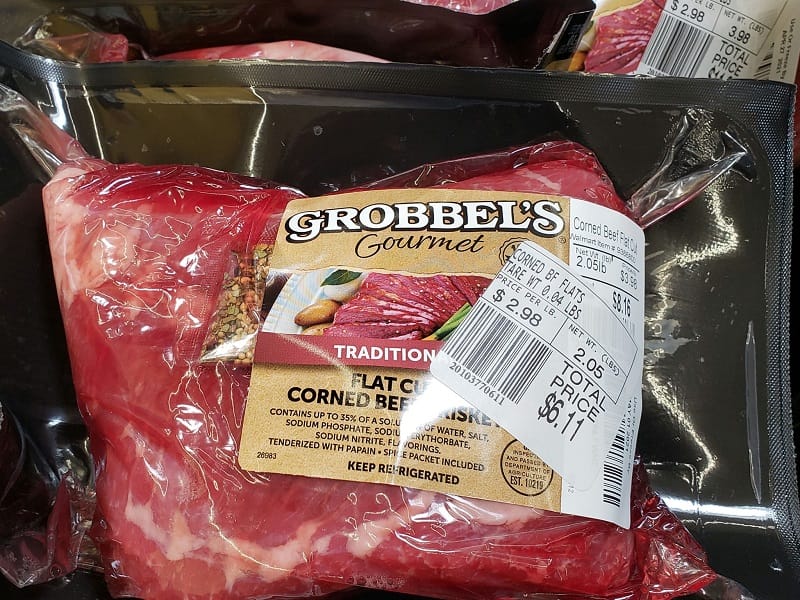
By following these tips for selecting high-quality corned beef brisket, you’ll surely find a cut of meat that is both delicious and nutritious.
- First, consider the size of the corned beef brisket. Make sure to select a large cut to feed the number of people you are expecting. Corned beef brisket is usually sold in four- to five-pound packages, so choose accordingly.
- Second, consider the fat content of the corned beef brisket. The amount of fat in the brisket will determine how moist and tender the meat will be. Look for a cut with marbling of fat throughout, which will help keep the meat moist and tender as it cooks.
- Third, look for brisket with a rich, deep red color. The color should be uniform throughout the brisket, as any discoloration may indicate the meat is not fresh. Also, look for a brisket cut evenly, as uneven cuts can cause the meat to cook unevenly.
- Fourth, consider the brisket’s smell. You should be able to smell the beef’s aroma before you purchase it. If the beef has an off odor, you should avoid it. The smell should be pleasant and remind you of fresh-cooked beef.
- Finally, when you’re ready to purchase the corned beef brisket, read the label. Look for words like “certified organic” or “grass-fed,” as this indicates that the beef has been raised humanely and healthily. Also, check the sell-by date to ensure you’re buying the freshest cut possible.
The Difference Between Beef Brisket And Corned Beef
Beef brisket and corned beef are both cuts of beef, but there are some important differences to consider when deciding which one to buy.
Beef brisket is a cut of beef from a cow’s breast or lower chest. It comes from the pectoral muscles and is generally tougher than other cuts of beef. Since it is so tough, it’s best cooked low and slow, either by smoking or braising. Smoked brisket is especially popular in the southern states, where it is often served as a main course.
On the other hand, corned beef is a type of cured beef. It is usually made from brisket but is cured in a brine solution containing salt and other seasonings such as sugar, garlic, and pickling spices. This process preserves the meat and adds flavor. Corned beef is most commonly served as deli meat but can also be boiled and served with vegetables or used in other dishes.
So, what’s the difference between beef brisket and corned beef? The main differences are in the way they are prepared and the flavors they offer. Beef brisket is tougher and may require slow cooking, while corned beef is cured and ready to eat. Beef brisket offers a smoky flavor, while corned beef offers a sweet and savory flavor.
What Are The Key Differences Between Corned Beef Brisket And Other Types Of Cured Meats?
One key difference between corned beef brisket and other types of cured meats is the curing method. While corned beef brisket is wet cured, many other cured meats, like prosciutto, salami, and pastrami, are dry-cured. Dry curing involves the application of a mixture of salt, sugar, nitrite, and/or nitrate directly to the meat’s surface. This method allows the meat to slowly dehydrate and develop its unique texture and flavor over a longer period.
Another difference lies in the flavor profiles of these cured meats. Corned beef brisket is known for its distinct tangy and slightly salty taste, thanks to the brine it is cured in. On the other hand, dry-cured meats tend to have a more concentrated and intense flavor, often influenced by the specific blend of spices used in the curing process.
Furthermore, the texture of corned beef brisket differs from that of other cured meats. Corned beef brisket is typically boiled or simmered until it becomes tender and easily falls apart. This cooking method produces a softer texture than dry-cured meats, typically sliced thinly and enjoyed as is or in sandwiches.
Lastly, the appearance of corned beef brisket sets it apart from other cured meats. The curing process gives corned beef it’s signature pink color, resulting from the reaction between the nitrates/nitrites used in the brine and the meat’s proteins. In contrast, other dry-cured meats often have a darker, reddish-brown hue due to the natural aging and drying process.
What Is the Difference Between Corned Beef and Pastrami?
Let’s start with corned beef. Corned beef is a type of beef cooked with large-grain salt, or “corn,” commonly found in the deli meat section of the grocery store. It is also popular in various dishes, such as corned beef hash, Reuben sandwiches, and boiled dinners. Corned beef is typically made from brisket, the cow’s chest area. It is a very lean cut of meat and is usually sold in pre-cooked form.
Now let’s talk about pastrami. Pastrami is very similar to corned beef but is usually made from the navel area of the cow. This cut of meat is much fattier than the brisket, so it is usually served hot. It is also smoked with various spices, giving it a distinctive flavor. Pastrami is often found in deli-style sandwiches, such as the Reuben and the pastrami on rye.
So, what’s the difference between corned beef and pastrami? The main difference is in the cut of meat used and how it is prepared. Corned beef is typically made from leaner brisket, which contains less fat. Pastrami is made from the navel area of the cow, which is much fattier. This added fat gives pastrami its unique flavor, which is why it is often served hot.
What Is The Ideal Temperature To Cook A Corned Beef Brisket?
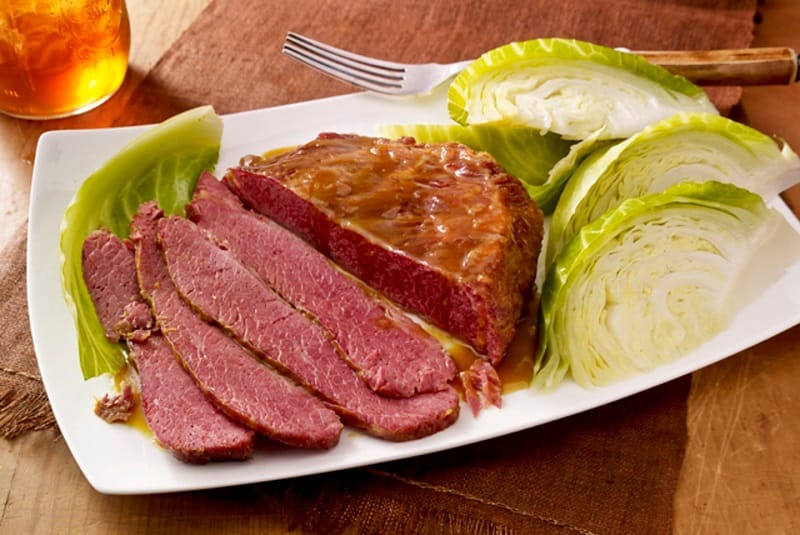
The ideal temperature to cook a corned beef brisket is between 180°F to 195°F. Although the meat is safe to eat when it reaches an internal temperature of 145°F, it will only be fork-tender and easy to slice around 180°F to 195°F. An oven temperature of 350°F is recommended, although it can be lowered to 275°F for smoked corned beef brisket. It is also advisable to remove the brisket from the oven or smoker when its internal temperature reaches 160°F and let it rest for an hour to allow the meat to absorb the flavors and be even more tender.
What Are Some Traditional Ways Of Serving Corned Beef Brisket?
There are several traditional ways to serve corned beef brisket. The most classic method is to slather it in mustard and pickles and serve it on a plate with boiled potatoes, carrots, and cabbage. Alternatively, you can slice it thin and pile it onto rye bread with pickles and mustard. If you’re feeling adventurous, you can also add a variety of other seasonings, such as garlic, bay leaves, and peppercorns.
Another popular way to serve corned beef brisket is to turn it into reubens. Pile the brisket on toasted rye bread with Swiss cheese, sauerkraut, and Thousand Island dressing to do this. Toasting the bread before adding the other ingredients will help the bread to hold up to the heavy ingredients.
You can also bake your corned beef brisket in a casserole or Dutch oven. To do this, layer the brisket in the dish with potatoes, carrots, and cabbage, and then top it with a mixture of sour cream, tomato sauce, and Worcestershire sauce. Bake at 350 degrees for about an hour or until the vegetables are tender and the sauce is bubbling.
Finally, you can also smoke your corned beef brisket. To do this, you will need a smoker and some hickory chips. Place the brisket in the smoker and place the hickory chips underneath. Smoke the brisket for about six to eight hours or until the internal temperature reaches 165 degrees. Serve the smoked corned beef brisket with the same accompaniments mentioned above.
Read more:
How to Cook Corned Beef?
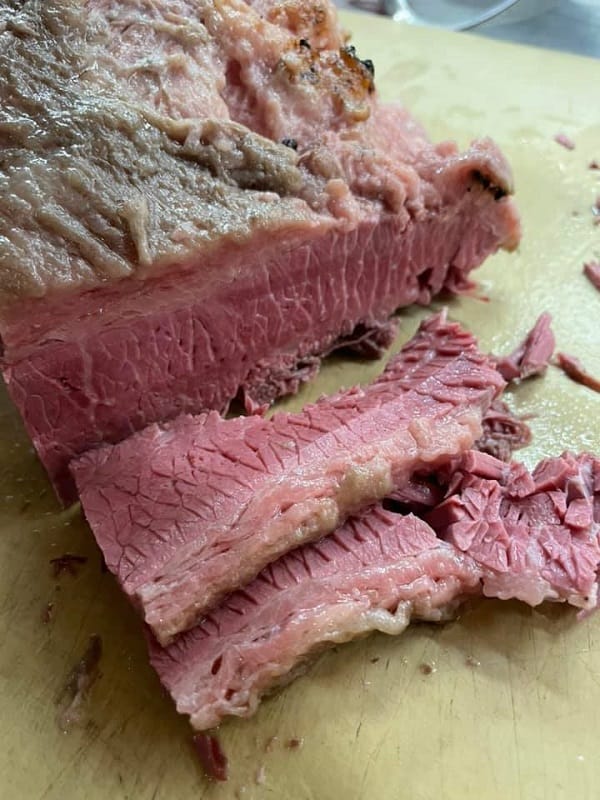
When cooking corned beef, there are two main methods – boiling and braising. Boiling is the most traditional method for classic, flavorful corned beef. You will need a pot large enough to hold your corned beef to get started. Once you’ve found the right size, fill it with two to three quarts of water. Add a tablespoon of pickling spices to the water and bring it to a boil. Once the water is boiling, add in your corned beef. Make sure to submerge the entire piece of beef. Then, reduce the heat to a simmer and cover the pot. Let the corned beef simmer for two to three hours or until tender.
On the other hand, braising is a more contemporary method of cooking corned beef. It is great for those looking for a more tender and flavorful result. To get started, you will need a large pot or Dutch oven. Heat a tablespoon of oil over medium-high heat and add corned beef. Brown the beef on all sides before adding a cup of broth or stock. Then, add some vegetables such as onions, carrots, celery, and potatoes, and let the mixture simmer for two to three hours or until the beef is tender.
No matter your chosen method, there are a few tips and tricks to remember while cooking your corned beef. Make sure to season your beef with salt and pepper before cooking it. This will help to bring out the flavors of the beef. Additionally, check on your beef every 30 minutes or so to ensure it is not overcooking. Add a few tablespoons of cider vinegar or white wine to the cooking liquid to give your corned beef a nice zesty flavor.
Can You Freeze Corned Beef Brisket?
When freezing corned beef brisket, the most important thing is to wrap it tightly. This will prevent the meat from drying out. You can use either plastic wrap, aluminum foil, or a vacuum sealer. Whichever method you choose, make sure you wrap the meat tightly and secure all of the edges.
It’s also important to label your packages with the date. This will help you remember when you put them in the freezer and will ensure that your corned beef brisket is safe to eat.
Once your corned beef brisket is properly sealed and labeled, it’s time to put it in the freezer. The best spot for freezing corned beef brisket is in the coldest part of the freezer, usually the back. This will help to keep it safe from any fluctuating temperatures.
When ready to eat your frozen corned beef brisket, thaw it in the refrigerator. This will ensure it’s safe to eat and help keep it from drying out. Once it’s thawed, cook it or put it in the refrigerator for up to three days.
How to Store Corned Beef Brisket?
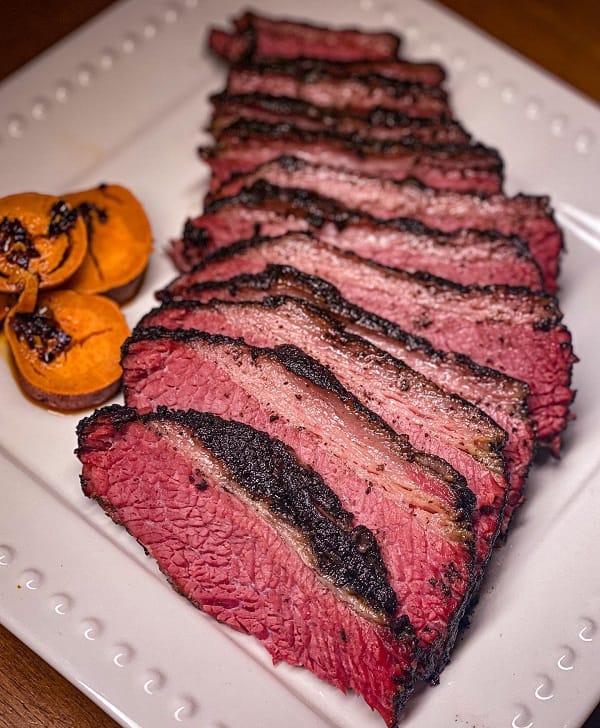
When it comes to buying, selecting, and preparing corned beef brisket, it’s important to understand that the quality of the meat can vary greatly. Look for brisket free of blemishes, bruises, or discoloration. The fat should be a consistent grayish-white, and the meat should be bright red and moist. Additionally, the beef should be firm but not too hard.
Once you’ve left the store with your corned beef brisket, it is important to store it properly. As soon as you get home, wrap the brisket tightly in a sheet of plastic wrap. This will help keep the meat fresh and prevent it from drying. Next, place the wrapped brisket in a shallow container and place it in the refrigerator.
When it comes to storing corned beef brisket in the freezer, the steps are very similar. Wrap the brisket tightly in a sheet of plastic wrap and place it in a freezer-safe container. Then, store it in the freezer for up to four months.
When you’re ready to cook your corned beef brisket, place it in a pot and add enough water to cover the meat. Then, bring the water to a boil and reduce the heat to a simmer. Simmer the brisket for two to three hours or until the meat is tender and cooked.
Are There Any Tips Or Tricks To Help Ensure A Moist, Flavorful Result When Cooking Corned Beef Brisket?
These tips and tricks will help ensure that your next corned beef brisket is a moist and flavorful success.
Before you begin, pick out the right cut of corned beef brisket. Look for cuts between 2 and 3 pounds with plenty of fat marbling. This will help to keep the meat moist throughout the cooking process.
Next, season your brisket with a dry-rub seasoning mix. This will help to add flavor and texture to the meat. Consider using a combination of garlic powder, ground black pepper, paprika, and thyme.
When it comes time to cook your brisket, cook it slowly. A low and slow cooking process will help to lock in moisture and increase the flavor. If you’re using a slow cooker, set it to low and cook the brisket for 8-10 hours. Preheat to 300°F and cook for 3-4 hours if you’re using an oven.
If you’re cooking your brisket in a liquid, use a flavorful one. Consider using beef broth, beer, or red wine. This will help to add even more flavor to the meat.
Once your brisket is finished cooking, let it rest for at least 15 minutes before serving. This will give the juices time to redistribute, resulting in a moist, flavorful corned beef brisket.
What Type Of Side Dishes Pair Well With A Traditional Serving Of Cornbeef Brisket?
The classic side to serve with corned beef brisket is a hearty potato dish. Mashed potatoes, boiled potatoes, or even roasted potatoes are all great options. For a touch of sweetness, try adding some applesauce to the potatoes. This will also help to cut through the richness of the corned beef.
Cabbage is a traditional vegetable side dish that goes well with corned beef brisket. Cabbage has a sweet flavor that pairs well with beef when cooked correctly. Add some bacon or ham to the cabbage to add a bit of crunch.
For a light side dish, try serving a salad. Not only is it a great way to add some freshness to the meal, but it is also a great way to get some extra vegetables in. Choose a salad with lots of crunchy vegetables, like carrots, celery, and cucumbers.
If you’re looking for a side dish that is a bit more unique, try adding some roasted carrots. Roasted carrots have a natural sweetness that pairs perfectly with beef. Try adding some garlic and herbs to the mix to make the carrots even more flavorful.
Are There Any Specific Seasonings Or Spices, Other Than Salt And Pepper, That Are Commonly Used When Preparing Corned Beef Brisket?
One widely used seasoning in corned beef brisket recipes is mustard seeds. These tiny seeds not only add mild heat but also impart a subtle tangy flavor that complements the rich and savory taste of the meat. Mustard seeds can either be ground and mixed with the other spices or left whole to infuse the dish with bursts of flavor.
Another popular spice that pairs well with corned beef is coriander seeds. These seeds have a citrusy, slightly sweet taste that adds a distinctive aroma and flavor to the meat. Coriander seeds can be toasted and ground before being used as a rub or added whole to the pickling liquid to infuse the meat with their fragrant essence.
In addition to mustard seeds and coriander seeds, many recipes call for the use of bay leaves. These aromatic leaves provide a subtle earthy note that complements the robust flavors of the beef. Bay leaves are often added to the pickling liquid, allowing their essence to penetrate the meat and impart a subtle but distinct flavor.
Garlic and onion are also commonly used seasonings when preparing corned beef brisket. These two ingredients not only add flavor but also help to tenderize the meat. Garlic, with its pungent and slightly sweet taste, adds depth and complexity, while onions provide a rich sweetness that balances the saltiness of the beef.
Herbs such as thyme and parsley can also be used to enhance the flavor of corned beef brisket. Thyme adds a subtle earthiness that complements the beef, while parsley adds freshness and a hint of mild bitterness. These herbs can be added to the pickling liquid or used to garnish the dish before serving.
While salt and pepper are the foundation of any good corned beef brisket, incorporating other seasonings and spices such as mustard seeds, coriander seeds, bay leaves, garlic, onion, and herbs can elevate the flavor profile and create a more well-rounded and delicious dish. These additional seasonings and spices not only enhance the taste of the beef but also bring a unique and aromatic element to this traditional favorite.
How Does The Salt-Curing Process Contribute To The Tender And Flavorful Nature Of Corned Beef Brisket?
Now, let’s get to the tender and flavorful nature of corned beef brisket. The key lies in the salt-curing process itself. When done properly, the meat becomes seasoned and balanced, with a complex flavor thanks to the combination of salt, water, and pickling spices.
The curing salt, also known as pink salt, plays an important role here. It actually enhances the beef brisket’s flavor and gives corned beef its characteristic color. This salt, which contains nitrite, helps preserve the meat by inhibiting the growth of bacteria, preventing spoilage, and preserving the meat’s color and flavor. So, it’s not just about taste but also about keeping the meat fresh and appetizing.
Speaking of taste, the curing salt adds more flavor to the meat. It also helps preserve the beef better if you don’t cook it right away after curing. So, you get that extra burst of flavor and a longer shelf life for your corned beef.
Aside from the salt, water plays a crucial role in the brine. It not only adds moisture to the meat but also enhances its texture. Imagine a juicy and tender slice of corned beef, and you’ll understand why water is so important in the salt-curing process.
To make the brine, you’ll need water, kosher salt, and pickling spices. Here’s the fun part: you can get creative with the spices. Add mustard seed, pickling spice, or any combination that appeals to your taste buds. The goal is to create a salty curing brine that infuses the meat with amazing flavors.
And here’s an interesting fact – did you know that 1 and 2.5-pound quantities of this brine can be used to cure up to hundreds of pounds of meat? That’s a whole lot of deliciousness right there!
What Is Corned Beef Brisket – FAQs
Is It Safe To Freeze Cooked Corned Beef Brisket, And If So, How Long Will It Remain Fresh In The Freezer?
It is safe to freeze cooked corned beef brisket and remain fresh in the freezer for up to 2 to 3 months. Freezing cooked corned beef brisket is a great way to save leftovers for a later time. To ensure the beef remains fresh and delicious, storing it in an airtight container or freezer bag is best. When ready to consume, thaw the beef in the refrigerator overnight before reheating. It is important to note that freezing cooked beef multiple times can affect its taste and texture, so only freeze it once. Overall, freezing cooked corned beef brisket is a safe and convenient way to enjoy it at a later time.
Common Mistakes To Avoid When Cooking Corned Beef Brisket
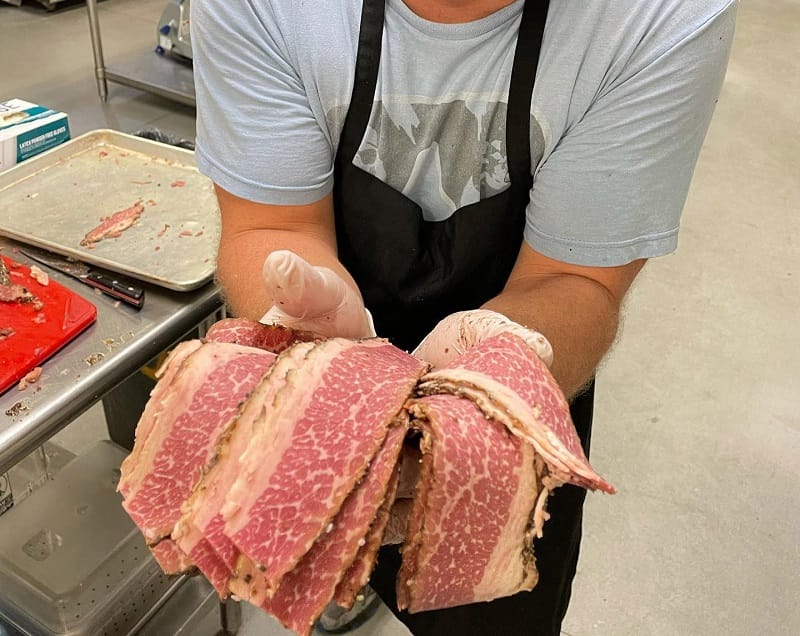
Corned beef brisket is a delicious and popular dish many people enjoy, but common mistakes can be made when cooking it. To avoid these mistakes, it is important to choose the right cut of meat and cook it properly.
- One common mistake is not to soak the brisket in water for at least 24 hours before cooking it. This can result in a tough and dry brisket that is difficult to chew.
- Another mistake is overcooking the brisket, making it tough and dry. To avoid these issues, it is recommended to cook the brisket low and slow for several hours until it is tender and juicy.
- Additionally, it is important to let the brisket rest 10-15 minutes after cooking before slicing it.
Conclusion
Corned beef brisket can be used in various recipes, including sandwiches, tacos, and stews. It is also popular in Reuben sandwiches and is often used in Jewish delis.
Corned beef brisket is a delicious and versatile dish that can be enjoyed in many ways. Whether you’re celebrating a special occasion or just looking for a delicious meal, it’s a great option.
Do you have any questions about what is corned beef brisket? Let us know in the comments below.
References:
- https://blog.thermoworks.com/beef/thermal-tips-st-patricks-day-corned-beef/
- https://www.freep.com/story/life/food/recipes/2017/08/14/barbecue-beef-brisket-recipe/104295884/

Hey readers! Chip Holland here, and I’m a Manager of this website. My passion for writing about it only matches my passion for BBQ. Follow my blog for mouth-watering recipes, tips, and tricks for the perfect smoke, grill, and BBQ. I’m sure you won’t be disappointed!
